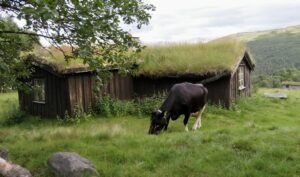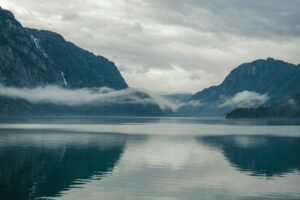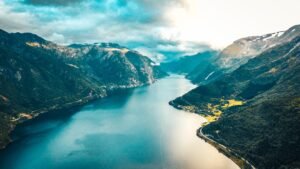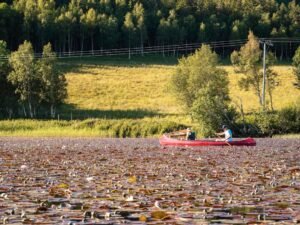
Discover Norse Mythological Beasts & Lore
Are you ready to embark on a mythical journey through the enigmatic realms of Norse mythology? Uncover the captivating stories and ancient lore surrounding the legendary creatures that have fascinated generations. From fearsome beasts to ethereal beings, Norse mythology is a treasure trove of fascinating creatures that will ignite your imagination and challenge your understanding of the world.
Table of Contents
ToggleKey Takeaways:
- Explore the rich tapestry of Norse mythology and its mythical creatures.
- Discover the significance of these creatures in Norse culture and their roles in ancient sagas.
- Delve into the Nine Realms and encounter giants, elves, and dwarves.
- Unravel the legends of Jotnar, dragons, serpents, and sea monsters that roam Norse mythology.
- Uncover the intriguing stories of wolves and other mysterious beasts, allies, and adversaries to the gods.
Norse Mythology: A Brief Introduction
Welcome to the enchanting world of Norse mythology, where gods, goddesses, and mythical creatures intertwine to create a captivating tapestry of ancient lore. Before we embark on our journey through the realm of Norse mythological beasts, let’s first uncover the foundations of this fascinating pantheon.
In Norse mythology, a pantheon of gods and goddesses reigns supreme over the Nine Realms, each with its distinct characteristics and inhabitants. At the center of this divine hierarchy is Asgard, the realm of the mighty gods, led by the wise and powerful Odin, and home to his son Thor, the god of thunder.
Not far from Asgard lies Vanaheim, the realm of the Vanir, a group of gods associated with fertility, nature, and wisdom. Freyja, the goddess of love and beauty, and Freyr, the god of fertility and prosperity, are prominent figures in Vanaheim.
Midgard, the realm of humans, is situated in the center of the Nine Realms and is connected to Asgard by the mythical Bifrost, a rainbow bridge. Midgard is teeming with mortal beings who, in Norse mythology, have close ties to the gods and often find themselves entangled in their adventures.
The remaining realms include Jotunheim, the land of the Jotnar or giants, a diverse group of beings known for their immense strength and often antagonistic relationship with the gods. In Svartalfheim, the realm of the dwarves, skilled craftsmen with unparalleled craftsmanship are said to reside.
Other realms such as Alfheim, the realm of the light elves, and Nidavellir, the realm of the dark elves, showcase the rich diversity of Norse mythology.
To provide a clear overview, here is a table summarizing the major gods and their respective realms:
| God/Goddess | Realm |
|---|---|
| Odin | Asgard |
| Thor | Asgard |
| Freyja | Vanaheim |
| Freyr | Vanaheim |
| Tyr | Asgard |
| Heimdall | Asgard |
| Loki | Asgard |
| Baldr | Asgard |
As we immerse ourselves in the world of Norse mythology and its creatures, keep in mind the interconnected nature of the Nine Realms and the profound influence each realm has on the mythological beings that reside within.
Creatures of the Nine Realms
In Norse mythology, the Nine Realms are a central feature of the cosmology, each realm inhabited by a unique array of mythical creatures. Let us embark on a journey through these realms, encountering the diverse beasts that call them home.
Asgard: Realm of the Gods
As the realm of the gods and the seat of power, Asgard is home to a host of divine beings. Here, we find mighty warriors, wise rulers, and legendary creatures such as the fearsome Fenrir.
Midgard: Realm of Humans
Midgard is the realm of humans, where mortal warriors and ordinary folk dwell. Although not home to many fantastical creatures, Midgard does see the occasional visit from other realms, such as the mischievous Loki.
Jotunheim: Realm of Giants
Jotunheim is a realm dominated by fearsome giants, ancient beings of immense strength and power. Ranging from towering Jotnar to the cunning Frost Giants, these creatures epitomize the raw force of Norse mythological beasts.
Niflheim: Realm of Ice
In the cold and treacherous realm of Niflheim, mythical creatures thrive amidst frozen landscapes. Here, we encounter the mythical beast known as Hrimthursar, the ice giants, who embody the harshness and unforgiving nature of this realm.
Vanaheim: Realm of the Vanir
Vanaheim is the realm of the Vanir, a fertility and nature-focused pantheon of gods. It is also home to other magical beings, such as the elf-like Vanir elves, who possess enchanting beauty and mysterious powers.
Alfheim: Realm of Light Elves
The realm of Alfheim is inhabited by light elves, ethereal beings renowned for their radiant beauty and connection to nature. These creatures bring an aura of enchantment and grace to the Nine Realms.
Svartalfheim: Realm of Dark Elves
Deep beneath the earth lies the realm of Svartalfheim, home to the secretive dark elves. Skilled craftsmen and artisans, the dark elves are known for their cunning and their intricate creations, such as the powerful giant-slaying weapon Mjolnir.
Muspelheim: Realm of Fire
Muspelheim is a realm consumed by fire and heat, where fiery giants like Surtr reign supreme. These powerful beings are the embodiment of destruction and chaos, representing the elemental and destructive forces of nature.
Helheim: Realm of the Dead
Helheim is the realm of the dead, presided over by the fearsome and enigmatic goddess Hel. Amongst its haunting landscapes, one can find monstrous creatures like the dragon Nidhogg, who gnaws at the roots of the cosmic tree Yggdrasil.
Table of Creatures in the Nine Realms:
| Realm | Creature |
|---|---|
| Asgard | Fenrir – The monstrous wolf |
| Jotunheim | Frost Giants – Towering and powerful beings |
| Niflheim | Hrimthursar – Ice giants of unforgiving nature |
| Vanaheim | Vanir Elves – Enchanting beings of beauty and magic |
| Alfheim | Light Elves – Radiant creatures connected to nature |
| Svartalfheim | Dark Elves – Skilled craftsmen and artisans |
| Muspelheim | Surtr – Fiery giant and harbringer of destruction |
| Helheim | Nidhogg – Dragon that gnaws on the roots of Yggdrasil |
These creatures of the Nine Realms breathe life into the captivating world of Norse mythology, embodying the epic tales and rich cultural heritage of the Norse people.
Legendary Beasts: Jotnar and Dragons
In Norse mythology, the pantheon of mythological beasts is as vast as the cosmos itself. Among these legendary creatures, two prominent categories hold a special place: the Jotnar and dragons. Revered for their awe-inspiring power and feared for their ferocity, these formidable beings have left an indelible mark on Norse mythology.
Jotnar: Giants of Ancient Legend
The Jotnar, also known as giants, stand tall as colossal figures in Norse mythology. They are renowned for their immense strength and unwavering resilience, making them formidable adversaries of the gods. With their origins rooted in the primordial realm of Jotunheim, the Jotnar personify the wild forces of nature and embody chaos and destruction.
These colossal beings often clashed with the gods, their epic battles shaping the cosmic order. In Norse sagas, Jotnar are depicted as cunning and unpredictable, capable of wielding unimaginable power. Some of the most notable Jotnar include:
*detailed information about Jotnar*
Dragons: Resplendent and Deadly
Dragons, revered for their majestic presence and fearsome nature, are another integral part of Norse mythology. These mythical beasts are often portrayed as fire-breathing creatures with immense wisdom and magical abilities. Dragons represent the eternal struggle between chaos and order, embodying both destructive and protective forces.
Their origins are intertwined with the primordial realms of fire and ice, symbolizing the dualistic nature of existence. From the fiery depths of Muspelheim to the icy realms of Niflheim, dragons have left their mark on Norse sagas and legends. Some of the most renowned dragons in Norse mythology include:
*detailed information about dragons*
A Comparison of Jotnar and Dragons
| Jotnar | Dragons |
|---|---|
| Known for their immense size and strength | Feared for their fiery breath and magical abilities |
| Primarily associated with chaos and destruction | Symbolize the duality of existence: chaos and protection |
| Often depicted as adversaries of the gods | Occasionally serve as guardians or allies to the gods |
| Origins in the primordial realm of Jotunheim | Origins intertwined with the realms of fire and ice |
Though Jotnar and dragons differ in many aspects, their immense power and symbolism make them captivating figures in Norse mythology. Whether as agents of chaos or protectors of realms, these legendary creatures continue to inspire awe and fascination in storytellers and enthusiasts alike.
Serpents and Sea Monsters
Explore the treacherous depths of Norse mythology as we encounter the captivating serpents and sea monsters that populate its vast seas. These mythical creatures pose formidable challenges to seafarers and heroes alike, creating an aura of danger and adventure. In this section, we will unravel the stories and symbolism associated with these extraordinary beings, shedding light on the fascinating realm of Norse mythological beasts.
Jormungandr: The Midgard Serpent
One of the most prominent serpents in Norse mythology is Jormungandr, also known as the Midgard Serpent. According to legend, this massive sea serpent encircles the entire world, grasping its own tail and creating an eternal cycle of life and destruction. Jormungandr’s sheer size and power make it a fearsome presence in Norse lore, instilling awe and trepidation in those who dare to venture into the vast oceans.
The Kraken: Myth or Reality?
The Kraken, a legendary sea monster of Norse folklore, continues to intrigue and inspire imagination throughout history. Described as a massive cephalopod-like creature with tentacles capable of capsizing ships, the Kraken embodies the terrifying power of the deep sea. While its existence remains shrouded in mystery, the tales of the Kraken serve as warnings of the perilous nature of the ocean and the unknown creatures that lurk beneath.
“Beneath the waves, where darkness dwells, the serpents and monsters of Norse lore guard their secrets, reminding us of the untamed power of the sea.” – Anonymous Norse seafarer
These serpents and sea monsters of Norse mythology symbolize the untamed forces of nature and the challenges that await those who venture into the unknown. Their stories serve as cautionary tales of the perils that lie beneath the surface and the importance of respect for the natural world. Let us dive deeper into the watery realms of Norse mythology to uncover the legends and mysteries surrounding these mythical creatures.
| Legendary Creatures | Description |
|---|---|
| Jormungandr | A colossal sea serpent that encircles the world, symbolizing eternal cycles and the vastness of the oceans. |
| The Kraken | A legendary sea monster capable of sinking ships, embodying the frightening power and unpredictability of the deep sea. |
Wolves and Other Mysterious Beasts
In Norse mythology, wolves hold a prominent place as both allies and adversaries to the gods. One of the most famous mythological beasts is Fenrir, the monstrous wolf and son of the trickster god Loki. The story of Fenrir’s creation and eventual role in the Ragnarok, the apocalyptic battle of the gods, adds an intriguing layer to Norse mythology. His immense size and strength symbolize the unstoppable forces of chaos, challenging the gods at every turn.
But Fenrir is not the only wolf of Norse lore. He has two equally fascinating siblings: Skoll and Hati. Skoll is said to chase the sun, eager to devour it during Ragnarok. Hati, on the other hand, pursues the moon, relentlessly trying to seize it from the night sky. These siblings represent the continuous struggle between light and darkness, woven into the fabric of Norse myth.
Aside from wolves, Norse mythology showcases a variety of lesser-known but equally captivating creatures. Here are a few examples:
- Hrimthursar: These frost giants inhabit the freezing realm of Jotunheim and are known for their immense power and icy temperament. They play a significant role in Norse mythology, often challenging the gods and fueling the ongoing conflict between order and chaos.
- Garmr: Garmr is a monstrous hound that guards the gates of the underworld, Helheim. He is described as a blood-stained beast with glowing red eyes, ready to unleash his ferocity upon anyone who dares to intrude into the realms of the dead.
- Vargr: These mysterious creatures are often referred to as “werewolves” in Norse mythology. They embody the duality of human nature, capable of transforming from human to wolf and tapping into the primal instincts that lie dormant within.
These diverse creatures, alongside the wolves of Norse myth, contribute to the rich tapestry of mythical beings that populate the realms of Norse lore. They serve as symbols, metaphors, and challenges, offering glimpses into the complex beliefs and values of the ancient Norse culture.
| Mythological Beast | Significance |
|---|---|
| Fenrir | Symbolizes untamed chaos and the immeasurable power of destruction. |
| Skoll and Hati | Represent the eternal struggle between light and darkness. |
| Hrimthursar | Personify the destructive forces of nature and challenge the order established by the gods. |
| Garmr | Stands guard at the gates of the underworld, providing a deterrent to those who would disturb the realm of the dead. |
| Vargr | Reflects the interconnectedness of human nature and the balance between civilization and untamed wilderness. |
Creatures of Light and Darkness
In Norse mythology, the world is not simply divided into forces of light and forces of darkness. Instead, it is a complex tapestry where radiant beings and mysterious entities coexist, shaping the rich mythological landscape.
*Norse mythological beasts* representing light include the valkyries. These ethereal maidens, often depicted as beautiful and fierce warriors, serve the gods and guide fallen heroes to the afterlife. Valkyries embody valor, protection, and the honorable path of the fallen warrior. They are key figures in Norse lore, symbolizing honor, bravery, and the triumph of the righteous in battle.
On the other side of the spectrum, we have creatures that represent darkness, such as the Nidhogg. This fearsome dragon-like being dwells at the roots of the World Tree, Yggdrasil, and gnaws at its core. The Nidhogg embodies chaos, destruction, and the relentless force of evil. Its presence serves as a reminder of the eternal struggle between order and chaos, light and darkness.
The Valkyries: Divine Maidens of Battle
*Norse mythology creatures* are often as diverse as they are fascinating. The valkyries, or “choosers of the slain,” embody both beauty and strength. These divine maidens serve Odin, the Allfather, and are often depicted riding into battle on their noble steeds, wielding spears and shields. Their divine duty is to select fallen warriors on the battlefield, guiding them to the grand halls of Valhalla, where they prepare for the final battle of Ragnarok.
“The valkyries, with their shimmering armor and resolute gazes, inspire awe and admiration among mortals and deities alike. They are the divine embodiment of bravery, valor, and fate.”
The valkyries possess the power of prophecy, seeing the destinies of mortal warriors before they meet their untimely demise. Their presence on the battlefield signals a higher purpose, a celestial intervention in the affairs of mortals. Through their guidance, valiant warriors are elevated to a higher plane of existence, eternally prepared to fight alongside the gods when the time comes.
The Nidhogg: Devourer of the World Tree
*Norse mythological beasts* come in all forms, and the Nidhogg is a formidable embodiment of darkness and destruction. This fearsome dragon-like creature resides in the darkest depths of the underworld, gnawing at the roots of Yggdrasil. As it hungrily devours the World Tree, it seeks to unravel the delicate balance that holds the realms of Norse mythology together.
“The Nidhogg’s insatiable appetite for chaos and destruction reminds us of the fragile nature of cosmic order. It represents the eternal struggle between light and darkness, challenging mortals and deities alike to maintain harmony in an ever-changing world.”
While the valkyries inspire warriors with hope and honor, the Nidhogg lurks in the shadows, a constant reminder that even the mightiest forces must contend with darkness. It is a symbol of the challenges and temptations that must be overcome to maintain order and preserve the delicate fabric of the Norse mythological realms.
| Beings of Light | Dark Entities |
|---|---|
| Valkyries | Nidhogg |
| Luminous and ethereal warriors guiding fallen heroes | Fearsome dragon-like creature devouring the World Tree |
| Embody honor, bravery, and righteousness | Symbolize chaos, destruction, and the force of evil |
Conclusion
Our journey through the world of Norse mythological beasts has been nothing short of extraordinary. We have delved into the captivating legends and creatures that have enchanted our imagination. From the mighty giants of Jotunheim to the awe-inspiring serpents of the sea, Norse mythology is a treasure trove of mythical creatures that continue to inspire and intrigue us today.
The rich tapestry of Norse lore is adorned with a diverse array of mythical beings. These creatures not only shaped the ancient Norse culture but also provided insight into the beliefs and values of their society. The giants, dragons, and wolves that populate the realms of Norse mythology symbolize the eternal struggle between forces of light and darkness, embodying the complexities of human nature.
As we bid farewell to the captivating world of Norse mythological beasts, we carry with us a deeper appreciation for the imaginative tales and the enduring legacy of the Norse people. The allure of these mythical creatures is everlasting, reminding us of the power of storytelling and the timeless nature of human fascination with the unknown. Norse mythology creatures will continue to ignite our curiosity and inspire new generations to explore the realms of the gods and monsters that have left an indelible mark on our collective imagination.
FAQ
What are Norse mythological beasts?
What is Norse mythology?
Which mythical creatures are associated with Norse lore?
What is the significance of Norse mythological beasts in Norse culture?
Are there any real-life connections to Norse mythological beasts?
Where can I learn more about Norse mythological beasts?
If you want to learn Norwegian, you can register for classes here. We look forward to hearing from you and helping you become fluent in Norwegian.





